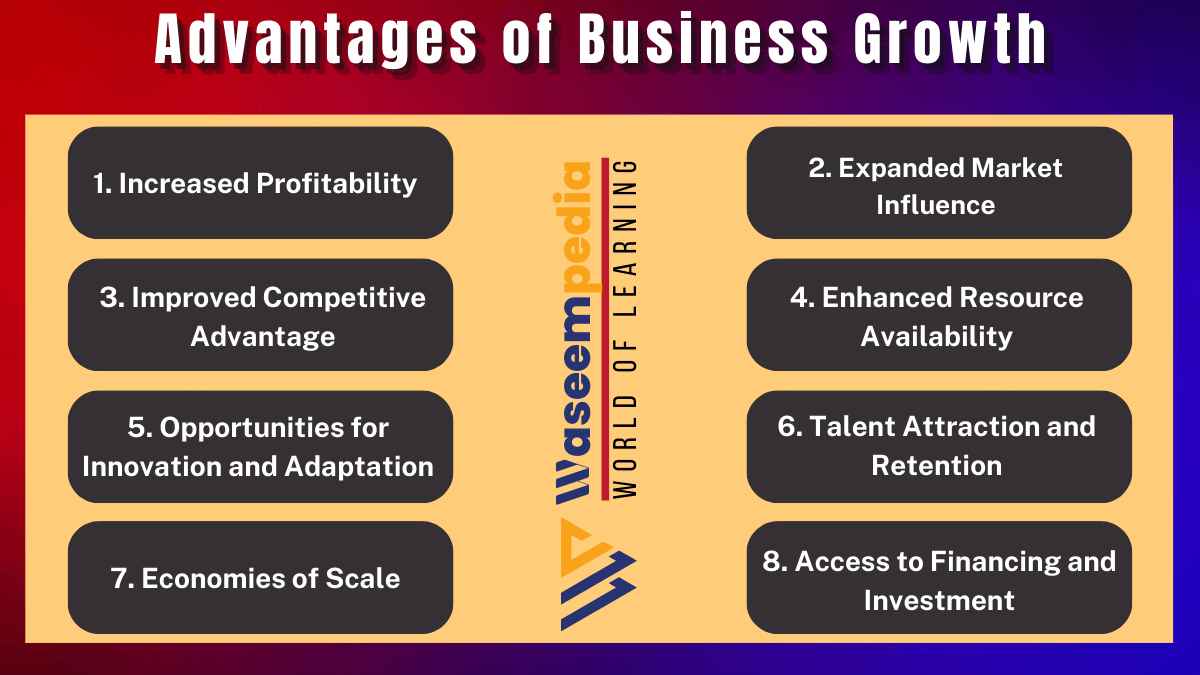Business growth offers a multitude of advantages that contribute to the long-term success and sustainability of organizations. From increased profitability and market influence to improved competitive advantage, resource availability, and access to financing, the benefits of business growth are significant. By embracing growth opportunities and implementing effective strategies, businesses can position themselves for a prosperous future, achieve their goals, and make a lasting impact in the marketplace.

Business growth is a key objective for entrepreneurs and organizations alike. It represents progress, success, and the ability to expand and thrive in a competitive marketplace. This article explores the advantages of business growth and highlights the benefits it brings, such as increased profitability, market influence, and resource expansion.
Business growth is a crucial driver of success, enabling organizations to achieve their goals and realize their full potential. As businesses expand and evolve, they unlock numerous advantages that contribute to their long-term sustainability and profitability. Let’s explore the key advantages of business growth.
8 Advantages of Business Growth
There are many advantages of business growth but 8 Advantages of Business Growth are as following.
1. Increased Profitability
One of the primary advantages of business growth is increased profitability. As a business expands its customer base, product offerings, or geographic reach, it opens up new revenue streams and opportunities for higher sales volumes. With economies of scale and efficient operations, businesses can generate higher margins, achieve cost savings, and improve their bottom line.
2. Expanded Market Influence
Business growth allows organizations to expand their market influence and reach. By entering new markets or capturing a larger share of the existing market, businesses can increase their brand visibility and customer base. This expanded market influence not only drives revenue growth but also enhances the organization’s reputation and competitive position.
3. Improved Competitive Advantage
Business growth enables organizations to gain a competitive advantage in the marketplace. With increased resources, market share, and brand recognition, growing businesses are better positioned to outperform competitors. They can invest in research and development, improve product quality, and offer competitive pricing, attracting more customers and securing a stronger market position.
4. Enhanced Resource Availability
As businesses grow, they gain access to a wider range of resources. This includes financial resources, human capital, technological infrastructure, and operational capabilities. With these additional resources, organizations can invest in new technologies, hire top talent, expand their production capacity, and improve overall efficiency. This enhanced resource availability supports further growth and innovation.
5. Opportunities for Innovation and Adaptation
Business growth creates opportunities for innovation and adaptation. With increased financial stability and market influence, organizations can allocate resources towards research and development initiatives. They can innovate their products, services, or business models to meet changing customer demands and stay ahead of industry trends. This agility and ability to adapt to evolving market dynamics contribute to long-term success.
6. Talent Attraction and Retention
Growing businesses often attract top talent in the industry. As organizations expand, they create new job opportunities and offer career advancement prospects. This attracts skilled professionals who are seeking growth-oriented environments. Additionally, established businesses can provide competitive compensation packages, training programs, and a positive work culture, promoting employee satisfaction and retention.
7. Economies of Scale
Business growth allows organizations to achieve economies of scale. With increased production volumes, businesses can negotiate better deals with suppliers, reduce per-unit costs, and improve operational efficiency. This cost advantage allows for higher profitability and the ability to offer competitive prices to customers, further strengthening their market position.
8. Access to Financing and Investment
As businesses grow and demonstrate a track record of success, they gain access to a wider range of financing options. Lenders and investors are more likely to support growing businesses with loans, credit lines, or equity investments. This additional capital infusion can be used to fuel further growth initiatives, expand operations, or invest in strategic opportunities.
Related FAQ’s
What are the advantages and disadvantages of business growth?
Advantages of Business Growth:
Increased Revenue and Profits
Market Expansion and Diversification
Economies of Scale
Enhanced Competitive Advantage
Attraction of Top Talent
Disadvantages of Business Growth:
Increased Complexity and Risk
Management Challenges
Potential Loss of Agility
Higher Costs
Cannibalization of Existing Markets
What is the use of business growth?
The use of business growth is to increase revenue, expand market presence, and achieve higher profitability, often leading to improved competitiveness and sustainability.
What is business and its advantages?
Business is the pursuit of profit through the provision of goods or services. Its advantages include wealth generation and job creation, contributing to economic growth.
What is most important for business growth?
The most important factors for business growth are effective strategy, customer satisfaction, and financial management.
What are the factors of business growth?
Key factors of business growth include market demand, strategic planning, financial stability, innovation, and effective marketing.

